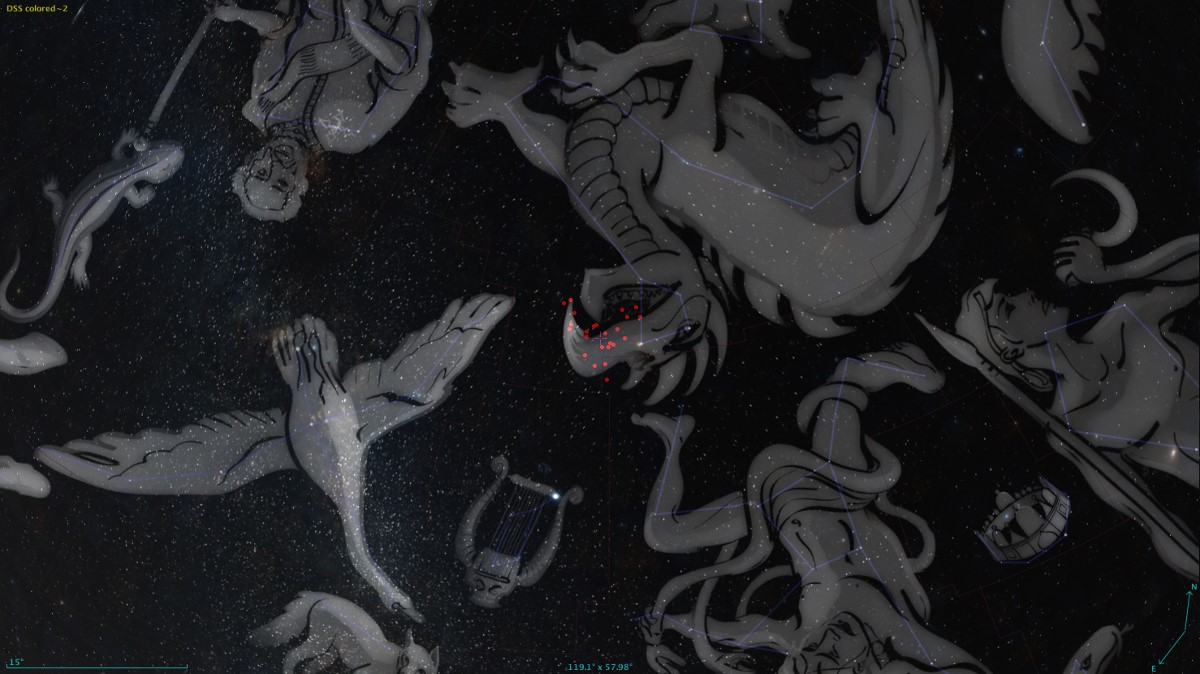Taking our Galaxy as a vast sea, astronomers are the fishing men using telescopes to catch light from different objects. Recently, thanks to the Large Sky Area Multi-Object Fiber Spectroscopic Telescope (LAMOST), a team lead by Dr. John Vickers and Prof. Martin Smith from the Shanghai Astronomical Observatory (SHAO) has discovered a previously unknown streaming population and they suggested that it may be the remnants of a disrupting star cluster. This work has been published in the Astrophysical Journal Letters on Jan. 1st, 2016.

In the schematic picture, red dots denote the previously unknown streaming population in the constellation of Draco.
The previously unknown stream of stars were discovered and suggested to be born together.
“We trawled the LAMOST data and noticed a small group of stars which appeared to be moving together, against the general flow of other stars in the area.” Dr. Vickers said, “further inspection showed that these rogue stars also had similar chemical compositions -- a good sign that they could be related.” The group of stars are located in the constellation of Draco, about 9400 light years away from the Sun.
Another way to check if stars are related is to see if they are about the same age. Dr. Vickers explained, “clusters of stars generally form at nearly the same time, since once the first stars form, radiative feedback will tend to blast the free gas out of the system, making further star formation difficult.”
It is well known that stars change in color and brightness as they grow older, depending on how massive they are. Stars of different masses progress through this process at different speeds and with different temperature - brightness relations. So for any given age, you can estimate the temperature and brightness of a massive star like Betelgeuse, a normal sized star like the Sun, or a small star like Proxima Centauri. A line of a constant age in this temperature - brightness space is called an isochrone. If many stars in a group are close to an isochrone, there is a good chance they have the same age.
“We want to know where these stars came from.”
The group of stars found in the study have similar chemical compositions, similar motions through the Galaxy, and look to be of a similar age to each other. This evidence implies that the stars were born together and constitutes the basis for the discovery of this so called “stream.” The next step is to determine what type of “progenitor” or family the stars came from.
“In general, stars are born in two types of progenitors: galaxies and star clusters. A star cluster is formed from a single burst of star formation, which stops when the first stars start blowing the gas out of their neighborhood; on the other hand a galaxy has enough mass to keep the gas from being blown away, and hence has an ongoing history of star formation.” Prof. Smith said.
“From the number of stars observed, we estimate that the stars come from a relatively small progenitor.” Dr. Vickers said. Is the progenitor a dwarf galaxy or a cluster?
The stars examined have a relatively high metallicity. This means that the gas from which they were born had already been processed by stars before — they are the second, or third, or even higher, generation stars.
If the stars were from a dwarf galaxy, with continual star formation, they would expect their metallicity to be much lower, or for there to be a lot more stars than were observed. To achieve metallicities as high as are observed requires very massive galaxy, such as a large dwarf galaxy like Sagittarius, or even a more massive galaxy like the Milky Way. This implies that the stars were instead born in a cluster, which usually form from clouds of gas residing in larger galaxies. This would explain the high metallicity relative to the size of the progenitor, since the Milky Way itself would have enriched the gas.
There are two types of clusters, which are split by various definitions within the Milky Way: open clusters[1] and globular clusters[2]. “The objects we observe travel a good distance away from the Galaxy, about 4,000 light years from the Galactic mid-plane. Combined with the fact that some portion of it remains so close together, instead of having been mixed up and merged into the Galaxy a long time ago, leads to the inference that these stars belong to a globular cluster, which has been named in honor of the discovering survey, LAMOST 1.”
[1] Open clusters are generally clumps of stars which resemble the majority of stars in the Galaxy — they are close to the disk of the Galaxy, they travel circularly around the Galactic center, and over time they get spread out and mixed up to eventually merge into the Galactic disk.
[2] Globular clusters on the other hand are oddball objects which do not go with the flow, oftentimes flying tens of thousands of light years above of below the Galaxy, travelling in bouncing “radial” orbits instead of calm circular ones.
Link to the research paper:http://adsabs.harvard.edu/abs/2016ApJ...816L...2V
Science contact:John Vickers, Shanghai Astronomical Observatory, johnjvickers@shao.ac.cn
Martin Smith, Shanghai Astronomical Observatory, dr.mcsmith@me.com
News contact: wenwenzuo@shao.ac.cn, , Shanghai Astronomical Observatory, 34775125